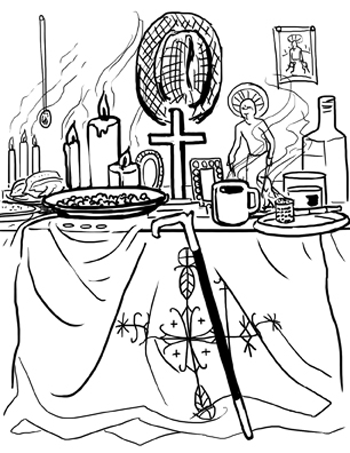News, Trail of Cthulhu
Call of Chicago: Ripped From the History Books: The Anti-Superstition Campaign, er, Campaign
 During the American occupation of 1915-1934, a wave of Protestant conversions spread through Haiti. Possibly as a result, Vodou congregations began to burn their drums, flags, instruments, and charmed objects, in order to “reject superstition.” The Catholic Church in Haiti saw these rejetes as the opening for a proper Catholic conversion wave, a campagne anti-superstitieuse: the Anti-Superstition Campaign. (The common voodoo practice of using the Eucharistic Host as a “magic item” contributed to the Church’s fervor.) Beginning in 1939, priests and lay brothers moved throughout the countryside where rejete movements had begun, converting peasants and local elites alike to orthodox Catholicism and urging the destruction and dissolution of Vodou temples, or houmforts. Medical missions provided drugs and treatment to the sick, showing up failed or empty houngan rituals. Priests carried the cross ahead of crowds shouting “Down with the Loa!” to bonfires of ritual objects in the houmfort’s peristyle. Those houngans who had lorded their status and power over the peasants found themselves powerless against priests with the peasants and the police at their back.
During the American occupation of 1915-1934, a wave of Protestant conversions spread through Haiti. Possibly as a result, Vodou congregations began to burn their drums, flags, instruments, and charmed objects, in order to “reject superstition.” The Catholic Church in Haiti saw these rejetes as the opening for a proper Catholic conversion wave, a campagne anti-superstitieuse: the Anti-Superstition Campaign. (The common voodoo practice of using the Eucharistic Host as a “magic item” contributed to the Church’s fervor.) Beginning in 1939, priests and lay brothers moved throughout the countryside where rejete movements had begun, converting peasants and local elites alike to orthodox Catholicism and urging the destruction and dissolution of Vodou temples, or houmforts. Medical missions provided drugs and treatment to the sick, showing up failed or empty houngan rituals. Priests carried the cross ahead of crowds shouting “Down with the Loa!” to bonfires of ritual objects in the houmfort’s peristyle. Those houngans who had lorded their status and power over the peasants found themselves powerless against priests with the peasants and the police at their back.
Initially, the authoritarian government of President Elie Lescot supported the Anti-Superstition Campaign, lending the Garde (the Haitian military police) to still more robust missions. “Superstitious practices” had been illegal since 1935, so the Garde’s destruction of houmforts (often also family houses) and seizure of land (the better to sell to United Fruit or the Haitian government rubber monopoly, SHADA) were just Haitian law enforcement at work. But in February 1942, the Church extended its campaign into Port-au-Prince, the Haitian capital, stirring up mass unrest where Lescot desired it least. Worse still, the apostolic nuncio Msgr. Silvani gave a fawning interview in the Dominican Republic explaining the campaign as an attempt to rationalize Haiti with the dictatorial (but devout) regime of Rafael Trujillo there. Rightly suspicious of Trujillo’s intentions to convert Haiti to a Dominican puppet state, the Haitian press turned on the Church and its campaigners. In March, Lescot ended government support for the campaign, and it fizzled out shortly thereafter.
So where is the Mythos? It lurks somewhere in Haiti, among the sects rouges or zobop societies of sorcerers and murderers. Or perhaps it is a new bauble for Trujillo or some eminence grise in his cabinet to toy with unwittingly. Or it gnaws at the bosom of the Church, as priestly despair in a sea of poverty turns to Hasturist nihilism. But it’s somewhere – and when people burn magic items in a remote jungle temple, so is the action. Herewith a number of possible Trail of Cthulhu campaigns, likely (but not lightly) seasoned with Voodoo.
- The Investigators are American or European outsiders, missionaries or other do-gooders trying to “better the lot” of the natives, or possibly mercenaries or hired cops training the Garde. The Keeper might use the anti-superstition campaign as background at first, but later force the heroes to decide: join a misguided, even cruel, effort in order to stop the Mythos, or stay true to their human standards?
- The Investigators are part of the Catholic Church hierarchy. They may be a globe-trotting team of demon-busting exorcists with Haiti the most recent stop, or they may be Haitian priests who have discovered Something in the deep jungles and wild mountains of the country. In either case, they might bring along a few NPC (or one or two player-character) members of the Garde for combat abilities and some broader skill bases.
- The Investigators might be using the anti-superstition campaign as cover for their own anti-Mythos campaign, or they might believe that the local Vodou communities are inseparably contaminated by the Mythos. One particularly interesting arc might start the Investigators off with the latter assumption – but as they travel deeper into the mystery, they slowly discover that the Vodou communities are the only things keeping the Mythos cults and zobop societies at bay.
- The Investigators are specifically part of the National Bureau of Ethnology, an alliance of Haitian, French, and American intellectuals headed by Jacques Romain, a well-connected Haitian poet, novelist, Communist, and ethnographer. They begin as staunch foes of the Church and its works, and as defenders of Vodou as “nationalist folk expression” – but when the unnamable enters their world through a Petro sect, what happens to their ideology? As a side note, Jacques Romain dies in 1944 of unknown causes at age 37, for Keepers of a conspiratorial mindset.
- The Investigators are part of a Vodou sect – possibly even a cell of a secret society in their own right – who begin the game square in the sights of the anti-superstition campaign, possibly with their houmfort burned down around them. They must still hunt down the Mythos and stop it, all the while dodging the Garde, Catholic priests, and perhaps agents of the Dominican dictator Rafael Trujillo.


